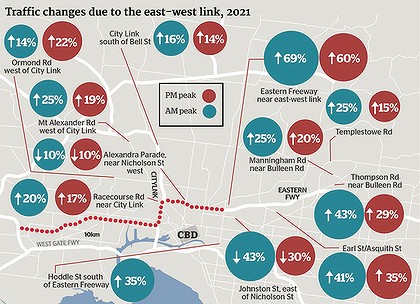
The Age reports on the traffic explosion predicted by this project. It explains some of the inconsistencies (or cover up) in the Comprehensive Impact Statement. There is a lively comments section too.
The east-west link will trigger huge increases in traffic on key sections of Melbourne’s road network, with parts of Hoddle Street and the Liberal stronghold of Kew among the worst hit.
The Napthine government’s own secret traffic modelling reveals hundreds of thousands of motorists face more rather than less congestion as a direct result of the $6 billion to $8 billion project.
The detailed forecasts, obtained by The Age, reveal traffic at the top of Hoddle Street near the Eastern Freeway – already one of Melbourne’s most congested spots – is expected to rise by up to 35 per cent during the morning peak by 2021 because of the project.
Traffic on other parts of Hoddle Street closer to the city is expected to improve by up to 9 per cent, but the figures appear to contradict government claims that overall congestion on Hoddle Street will be relieved by the project.
The report, prepared by consulting firm Veitch Lister for the Linking Melbourne Authority in July, also shows roads feeding into the Eastern Freeway will carry thousands more cars within the next eight years when the road, connecting the Eastern Freeway to CityLink, is completed.
Morning peak traffic on Manningham Road, in Bulleen, is tipped to increase by a quarter by 2021. Kew will also be hit. Morning peak traffic on Earl Street, for example, is expected to surge by up to 41 per cent once the road is completed.
According to the forecasts, the already heavily burdened Eastern Freeway will need to cope with a 69 per cent surge in the number of vehicles near the entrance to the tunnel, with an extra lane proposed to cope with the increase.
Details of the leaked report will create a further headache for the Napthine government, which has branded the road link a ”congestion busting” project for Melbourne. The government also has insisted repeatedly that the project stacks up economically, claiming benefits of $1.40 for every $1 invested.
In its publicly released Comprehensive Impact Statement, the Linking Melbourne Authority claims: ”Overall, the East West Link – Eastern Section is not forecast to have any major adverse impacts on the existing transport network.”
But the secret forecasts, which run to hundreds of pages and include detailed maps, show while some parts of the road network such as Johnston Street in Collingwood will improve, other areas will become more congested, largely because of a phenomenon known as ”induced demand”, where new roads can add to congestion across the network by encouraging people to drive.
A spokeswoman for Roads Minister Terry Mulder said the government had been ”completely transparent” with its traffic modelling, confirming there would be a significant increase in traffic on the Eastern Freeway and feeder roads.
”The studies project a major decrease in traffic on east-west routes such as Alexandra Parade, Johnston Street and Victoria Parade, among many others, while also showing a significant increase in traffic on the Eastern Freeway as traffic accesses the new tunnels,” she said. ”Roads like Thompson Road with direct access to the Eastern Freeway would be expected to increase.”
The figures show there will also be added pain at the western end of the tunnel. Racecourse Road, near CityLink, will need to cope with up to 20 per cent more cars during the morning peak, while Mount Alexander Road will carry up to 25 per cent more vehicles.
Melbourne University planning expert Dr Alan March said it was increasingly apparent that the money being spent on the road would be better invested in public transport, health or education. He warned that international evidence suggested such projects tended to add to traffic problems over the longer term.
”All of the evidence all over the world suggests these sorts of projects are unlikely to fix things in the longer term,” Dr March said. ”It is as if the government is determined to press ahead with a truck-based transport system at all costs irrespective of the impact on the rest of the city in the longer term.”
The leaked traffic predictions follow a report by the Victorian Auditor-General this year that suggested the tunnel was not the best way to deal with congestion. It warned not enough thought had gone into the question of whether the project might add to congestion by ”inducing extra road use”.